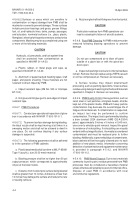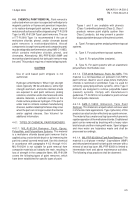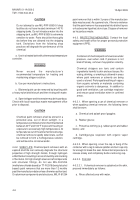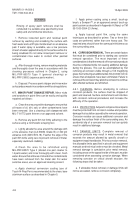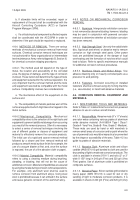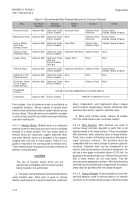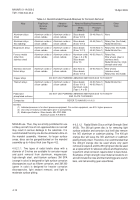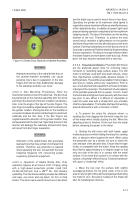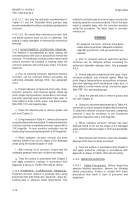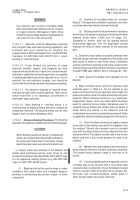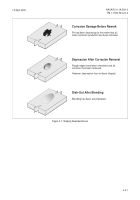TM-1-1500-344-23-2 - Page 90 of 240
4-14
NAVAIR 01-1A-509-2
TM 1-1500-344-23-2
15 April 2009
4-9.2.3. Pneumatic Sanders. The proper technique for
using pneumatic sanders with oscillating heads shall
include the following:
a. To prevent the sander from digging into the metal,
start the sander before it touches the metal. When the
sanding strokes are finished, lift the sander from the
metal before engaging the stop switch. Do not lay the
unit down with the motor running.
b. For best results, apply moderate pressure while
holding the sander against the work. Move the sander
over the surface with parallel and slightly overlapping
strokes. Move it as slowly as possible without overheating
the metal. Generally, the cleaning rate should be about
two square feet per minute.
CAUTION
Do not use flap brushes down to within 2 inches
of core. Continued use beyond this limit may
cause gouging due to loss of flexibility of fiber.
Excessive pressure on flap brushes will cause
polyurethane paint to melt, gum up, and streak
around the area being worked. Do not use on
nonmetallic surfaces.
4-9.2.4. Scotch-Brite™ Finishing Flap Brushes. Flap
brushes are made of non-woven, nylon, aluminum
oxide webbing. The brushes are very effective for
removing mild surface corrosion and prepping surfaces.
They can also be used for mechanical removal and
feathering of paint systems. The brushes are comprised
of a series of flaps attached to a mandrel, with each flap
impacting the surface as it spins. When used correctly,
the brushes will lead to minimal metal removal. The flap
brush and mandrel (see Figure 4-3) shall be assembled
so that the arrow, painted on the brush, is facing the
operator or the arrow is pointed in the direction of
rotation (clockwise). When using flap brushes, apply
minimal pressure to remove maximum paint and
minimum metal. To achieve maximum effectiveness,
use the specified RPM.
4-9.2.5. Abrasive Flap Wheels. Flap wheels
(MIL-W-81319) are made of nylon paper impregnated
with aluminum oxide abrasives (Figure 4-4). These
wheels usually come with a spindle mount. Depending
on grit size, the flap wheels can be used to remove
medium to severe corrosion from thick materials. The
wheels will also remove metal. Thus, caution must be
used to minimize the amount of metal removal. For the
most effective use of this equipment, use the specified
RPM.
4-9.2.6. Abrasive Cloth and Paper. Aluminum oxide
and silicon carbide cloth and paper can be used with
sanders and buffers by cutting suitable pieces from
stock.
CAUTION
Unless authorized by the cognizant aircraft
engineering authority, rotary wire brushes are
not authorized for corrosion removal on soft
metals, such as aluminum and magnesium.
4-9.2.7. Rotary Wire Brushes. Powered wire brushes
are available with various types of wire (straight, twisted,
or crimped), various lengths of wire (short, medium, or
long), and various wire densities (light, medium, or
heavy). Different actions can be obtained by varying
wire type, trim length, and density.
CAUTION
Improper use of the rotary file can damage
aluminum structure by creating thin spots
exceeding damage limits. Use of rotary files is
authorized only for severe granular or exfoliation
corrosion removal by qualified structural repair
technicians. Do not use rotary files to remove
corrosion from installed fasteners.
4-9.2.8. Rotary Files. Since it is one of the fastest ways
to remove corrosion and underlying metal, a rotary file
should be only handled by an experienced structural
repair technician. This tool is a tungsten carbide cylinder
or cone into which cutting edges have been machined.
When installed in the chuck of a pneumatic drill, rapid
metal removal can be achieved.
4-9.3. ABRASIVE BLASTING. During abrasive blasting,
abrasive media is propelled toward the work piece with
air pressure (conventional or vacuum blasting) or water
(wet blasting).
WARNING
Abrasive blasting operations create airborne
particles which may be hazardous to the skin
and eyes. A hood, gloves with gauntlets, and
adequate ventilation are required.
4-9.3.1. Conventional Equipment. Two types of
equipment are used to propel dry abrasives: direct
pressure feed and suction feed. In direct pressure
equipment, the abrasive holding tank is a pressure
vessel from which abrasive media is forced, through a
Back to Top

